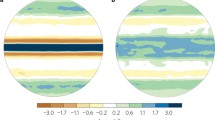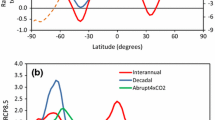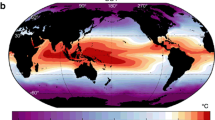Abstract
The water vapour feedback probably makes the largest contribution to climate sensitivity, and the second-largest contribution to its uncertainty, in the sense of disagreement between General Circulation Models (GCMs, the most physically detailed models of climate we have). Yet there has been no quantification of it which allows these differences to be attributed physically with the aim of constraining the true value. This paper develops a new breakdown of the non-cloud LW (longwave) response to climate change, which avoids the problems of the conventional breakdown, and applies it to a set of 4 GCMs. The basic physical differences are that temperature is used as the vertical coordinate, and relative humidity as the humidity variable. In this framework the different GCMs’ feedbacks look more alike, consistent with our understanding that their water vapour responses are physically very similar. Also, in the global mean all the feedback components have the same sign, allowing us to conveniently attribute the overall response fractionally (e.g. about 60% from the “partly-Simpsonian” component). The systematic cancellation between different feedback components in the conventional breakdown is lost, so now a difference in a feedback component actually contributes to a difference in climate sensitivity, and the differences between these GCMs in the non-cloud LW part of this can be traced to differences in formulation, mean climate and climate change response. Physical effects such as those due to variations in the formulation of LW radiative transfer become visible. Differences in the distribution of warming no longer dominate comparison of GCMs. The largest component depends locally only on the GCM’s mean climate, so it can in principle be calculated for the real world and validated. However, components dependent on the climate change response probably account for most of the variation between GCMs. The effect of simply changing the humidity variable in the conventional breakdown is also examined. It gives some of this improvement—the loss of the cancellations that leave the conventional breakdown of no use to understand differences between GCMs’ climate sensitivities—but not the link to mean climate.








Similar content being viewed by others
Notes
Conventions vary—here “λ” means the net radiative response to global-mean temperature changes, in W m−2/K, inversely proportional to climate sensitivity, and negative for a net negative feedback, i.e. a stable system.
References
Bony S, Colman R, Kattsov VM, Allan RP, Bretherton CS, Dufresne JL, Hall A, Hallegate S, Holland MM, Ingram WJ, Randall DA, Soden BJ, Tselioudis G, Webb MJ (2006) How well do we understand and evaluate climate change feedback processes?. J Clim 19:3445–3482
Cess RD, Potter GL, Blanchet JP, Boer GJ, Del Genio AD, Déqué M, Dymnikov V, Galin V, Gates WL, Ghan SJ, Kiehl JT, Lacis AA, Le Treut AA, Li Z-X, Liang X-Z, McAvaney BJ, Meleshko VP, Mitchell JFB, Morcrette J-J, Randall DA, Rikus L, Roeckner E, Royer JF, Schlese U, Sheinin DA, Slingo A, Sokolov AP, Taylor KE, Washington WM, Wetherald RT, Yagai I, Zhang M-H (1990) Intercomparison and interpretation of climate feedback processes in 19 atmospheric general circulation models. J Geophys Res 95:16601–16615
Colman R (2004) On the structure of water vapour feedbacks in climate models. Geophys Res Lett 31. doi: 10.1029/2004GL020708
Colman R, Fraser J, Rotstayn L (2001) Climate feedbacks in a general circulation model incorporating prognostic clouds. Clim Dyn 18:103–122
Edwards JM, Slingo A (1996) Studies with a flexible new radiation code. I: choosing a configuration for a large-scale model. Q J R Meteorol Soc 122:689–720
Hansen JE, Lacis A, Rind D, Russell G, Stone P, Fung I, Ruedy M, Lerner J (1984) Climate sensitivity: analysis of feedback mechanisms. In: Hansen JE, Takahashi T (eds) Climate processes and climate sensitivity. American Geophysical Union, Washington, DC, pp 130–163
Ingram WJ (2007) A simple physically-based model for the water vapour feedback on climate change, with applications. D.Phil. thesis, Department of Physics, University of Oxford
Ingram WJ (2010) A very simple model for the water vapour feedback on climate change. Q J R Meteorol Soc 136:30–40. doi:10.1002/qj.546
Ingram WJ (submitted) Some implications of a new approach to the water vapour feedback. Clim Dyn
Johns TC, Durman CF, Banks HT, Roberts MJ, McLaren AJ, Ridley JK, Senior CA, Williams KD, Jones A, Rickard GJ, Cusack S, Ingram WJ, Crucifix M, Sexton DMH, Joshi MM, Dong B-W, Spencer H, Hill RSR, Gregory JM, Keen AB, Pardaens AK, Lowe JA, Bodas-Salcedo A, Stark S, Searl Y (2006) The new Hadley Centre climate model HadGEM1: evaluation of coupled simulations. J Clim 19:1327–1353
Randall DA, Wood RA, Bony S, Colman R, Fichefet T, Fyfe J, Kattsov V, Pitman A, Shukla J, Srinivasan J, Stouffer RJ, Sumi A, Taylor KE (2007) Climate models and their evaluation. Climate change 2007: the physical science basis. Contribution of working group I to the fourth assessment report of the intergovernmental panel on climate change. Cambridge University Press, chapter 8, 589–662
Senior CA, Mitchell JFB (1993) Carbon dioxide and climate: the impact of cloud parameterization. J Clim 6:393–418
Simpson GC (1928) Some studies in terrestrial radiation. Mem R Meteorol Soc 2:69–95
Soden BJ, Held IM (2006) An assessment of climate feedbacks in coupled ocean-atmosphere models. J Clim 19:3354–3360
Soden BJ, Held IM, Colman R, Shell KM, Kiehl JT, Shields CA (2008) Quantifying climate feedbacks using radiative kernels. J Clim 21:3504–3520. doi:10.1175/2007JCLI2110.1
Williams KD, Ringer MA, Senior CA (2003) Evaluating the cloud response to climate change and current climate variability. Clim Dyn 20:705–721. doi:10.1007/s00382-002-0303-3
Williams KD, Senior CA, Mitchell JFB (2001) Transient climate change in the Hadley Centre models: the role of physical processes. J Clim 14:2659–2674
Acknowledgments
This work was funded by the joint DECC/DEFRA (GA01101) and MoD (CBC/2B/0417_Annex C5) Integrated Climate Programme at the Met Office, with writing up partly funded by NERC contract NE/D012287/1 and EU contract GOCE-505539. Much of this work is obviously based on the vast amount of effort and expertise invested in various forms of the MetUM, so I am indebted to all the scientists who contributed to its development. More specifically I am grateful to Jean-Claude Thelen, John Edwards and James Manners for help with the Edwards-Slingo LW code in both its stand-alone and MetUM forms. Keith Williams advised me on the slab simulations, and had also run them, apart from the HadSM2 ones, run by Chris Hewitt. I am also particularly grateful to Catherine Senior and Mark Ringer for their support.
This was part of a doctoral project at AOPP, where I am again grateful to many colleagues, particularly my supervisor Professor David Andrews, Myles Allen, Mark Munro, Stu Teasdale, Neil Massey, Matt Rigby, Helene Muri, Helen Hanlon and Ruth Cerezo-Mota. The presentation has benefitted from comments from reviewers and many colleagues at both affiliations and elsewhere, and opportunities to give oral presentations.
Author information
Authors and Affiliations
Corresponding author
Rights and permissions
About this article
Cite this article
Ingram, W. A new way of quantifying GCM water vapour feedback. Clim Dyn 40, 913–924 (2013). https://doi.org/10.1007/s00382-012-1294-3
Received:
Accepted:
Published:
Issue Date:
DOI: https://doi.org/10.1007/s00382-012-1294-3




